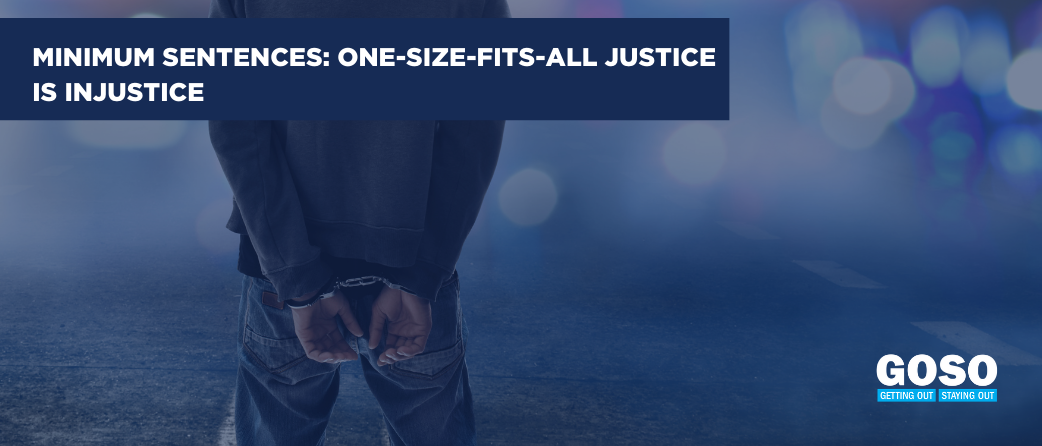Criminal Justice Month is still underway, and we ask that you join GOSO and our co-sponsors for an important conversation with New York City mayoral candidates on March 30, 2021, at 6PM EST. The Criminal Justice and Reentry Mayoral Forum is an opportunity for you to hear the mayoral candidates’ views on the school-to-prison pipeline, alternatives to incarceration, the criminalization of the poor, and the harsh mandatory sentencing guidelines that have caused our nation’s level of incarceration to increase 700% in recent decades.
The failure of minimum sentencing guidelines
One of the reasons Black and brown people in America experience incarceration more than any other nation is because of mandatory sentencing. In the latter half of the 20th century, a get-tough-on-crime mindset captured the American psyche and resulted in over-the-top legislation, such as the 1994 Crime Bill. In response to growing outrage over drugs and violence, this bill ratcheted up the ongoing War on Drugs.
The prevailing thinking at the time was that mandatory minimum sentences would give prosecutors and police more leverage in negotiating plea bargains, serve as a deterrent, remove personal biases from sentencing, and prevent judges from handing down sentences that may be too lenient. But this thinking ended up being completely misguided.
Mandatory minimum sentences lead to higher conviction rates and here have been countless examples and studies highlighting how these sentences have been applied incorrectly, especially when individuals are accused of nonviolent crimes. These guidelines also don’t allow judges to consider extenuating circumstances during sentences. Instead, they became a one-size-fits-all approach.
Disparities in sentencing
Minimum sentences also disproportionately affect Black Americans. One of the most glaring examples of this can be seen in the disparate sentences for the possession of crack cocaine versus powder cocaine. The possession of crack cocaine continues to carry harsher penalties than powder cocaine. If you consider how 81% of the people arrested for crack-related offenses in 2019 were Black, it becomes easier to see how the harsher sentences for crack cocaine disproportionately affect Black Americans
The ACLU and the Drug Policy Alliance (DPA) also report that Black Americans comprise only 15% of regular drug users, but represent 37% of individuals arrested, 59% of those convicted, and 74% of those sentenced to prison for drug offenses.
These mandatory sentences and discrepancies ultimately have the effect of exacerbating an already tenuous existence for Black Americans, where the ACLU estimates that one of every three Black boys are expected to go to prison in their lifetimes, compared to just one in every 17 White boys.
The financial burden to society
Expanded felony classifications, three-strikes rules, and mandatory minimums have also failed to lead to a decrease in crime rates nor have they significantly reduced drug use. Instead, they have increased the financial burden to society.
In New York, the average cost per inmate care annually is more than $60,000. In New York City, the cost per inmate exceeds $447,337 annually (2020). With mandatory minimum sentences extending the length of time prisoners must serve, there is a definite financial cost that we cannot afford.
Change for the better
Encouragingly, there’s hope that change is on the horizon. Representatives Hakeem Jeffries (D-NY), Bobby Scott (D-VA), Kelly Armstrong (R-ND), and Don Bacon (R-NE) have recently announced the introduction of the Eliminating a Quantifiably Unjust Application of the Law (EQUAL) Act. This bipartisan legislation aims to eliminate the disparity in sentencing for crack and powder cocaine offenses at the federal level, and to retroactively apply to anyone who has already been convicted or sentenced.
“The EQUAL Act will help reverse engineer the tragic legacy of the failed war on drugs which has devastated lives, families, and communities. There is no justification for treating powder cocaine differently than crack cocaine offenses. There is no pharmacological difference, no chemical difference, and no physical difference between how the body processes crack cocaine and powder cocaine. Crack cocaine has historically been used in inner-city communities and powder cocaine in affluent neighborhoods and the suburbs. Put simply, the dividing line is race and geography. That does not justify the wide disparity in sentencing” said Rep. Jeffries.
This new legislation is a positive step in the right direction. But we want to see more discretionary sentencing at the state judicial level, particularly for non-violent, first-time offenders who are unlikely to be repeat offenders. State legislators similarly need to embrace new laws that do away with mandatory sentencing for nonviolent offenses, not just drug possession. And we also believe that it’s critical to enlist mental health and drug counseling experts and community-based organizations like GOSO more often, rather than relying on police as the only response.
Changing our sentencing guidelines is long overdue; and GOSO has been doing its utmost to support young men achieve positive life goals. Our Court Advocacy program assists participants in avoiding jail time or reducing a potential sentence by engaging their attorneys, district attorneys and judges, and by appearing in court on their behalf. We write hundreds of letters each year attesting to participants’ hard work, both in our program and in the community.
In fact, over the last 16 years, GOSO has earned a reputation with the courts, other community service providers, government agencies, and defense attorneys as a program that provides effective services in lieu of jail or a prison sentence.
But we can’t do this work alone. We encourage you to join us in transforming the justice system and reversing the harm caused by our system of mass incarceration.
GET INVOLVED: Help GOSO recognize National Criminal Justice Month. SHARE this important op-ed and JOIN us for our upcoming events.

